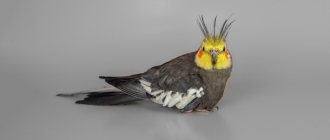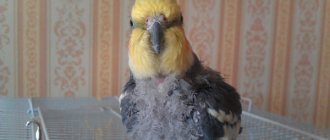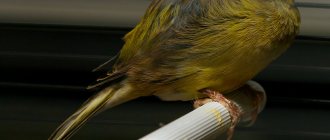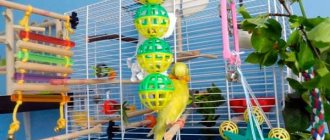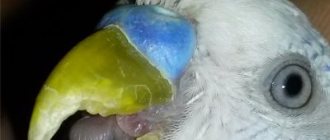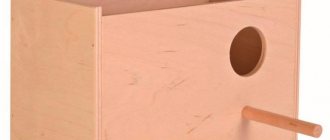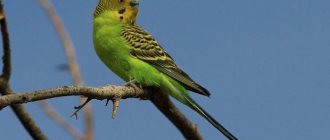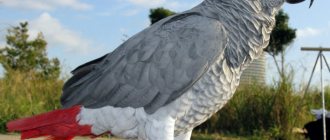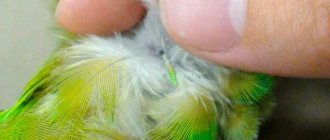Cell shape
There is a wide selection of bird cages in stores, but not all of them may be suitable. Square and rectangular shapes are the best option. But the round and cylindrical shapes of the cells can disorient the bird in space and cause apathy and even depression. This is due to the lack of corners.
Pay attention to the position of the rods. The vertical position does not allow the parrot to get caught and freely climb around the cage. Horizontal rods allow the bird to cling well with its beak or claws. But it is better if the weaving is in the form of a lattice.
Do not choose a cage with a large distance between the bars, otherwise the parrot will try to crawl through. As a result, he will simply get stuck and may die. Small weaving, in turn, will cause negativity on the part of the bird. Optimally, this is 2-3 cm between the rods.
Optimal design
Dimensions
Corella is a bird accustomed to freedom and large spaces, so the size of the cage must be appropriate and allow the parrot to move freely.
For a comfortable stay for a cockatiel, the dimensions of the home are:
- Length – 80 cm.
- Width – 40 cm.
- Height – 60 cm.
- The distance between the rods is from 1 to 2 cm.
When several birds live nearby in one place, the parameters increase several times, in proportion to the number of residents.
Using a smaller cage leads to injury and death of the bird, so the future owner should not save space.
Form
When purchasing a cage, special attention should be paid to its shape, the arrangement of the rods and the ability to extend the tray.
The parrot feels better and does not experience unnecessary excitement when its habitat has corners at the base, so a suitable bottom shape would be:
- Square.
- Rectangle.
As for the location of the rods, experts recommend choosing a horizontal direction, since parrots like to use the walls of the cage as a route for movement.
The tray in the cage can be either retractable or without such a function. Both options are not bad, but the first one is still more convenient, especially if cleaning occurs while the parrot is present.
Material
Proper housing for poultry recommended by experts must meet the following requirements:
- Possess the ability to quickly wash and clean.
- Be made from environmentally friendly materials.
- Be strong.
- Free from uneven surfaces, poor finishing and sharp corners.
The ideal option would be a cage made of stainless steel with nickel- or chrome-plated rods, but it is better to avoid wooden, copper and galvanized models with painting, since the parrot loves to chew rods and can harm its health.
Dimensions
When choosing a cage for a cockatiel by size, keep in mind that there are no specific parameters, the main thing is that it is spacious and comfortable. Here are just the minimum sizes suitable for the life of one parrot:
- 70 cm – height.
- 40 cm – width.
- 80 cm – length.
In this case, special attention is paid to the length, since the bird flies in a horizontal direction and if it is insufficient, it can damage the feathers, wings and tail.
Keep in mind that when you buy two birds, the size of the cage almost doubles!
What should a parrot's cage be like?
The house where this pet will live must be spacious. The following items must be placed in it: a special bathtub, a swing, wooden perches, a sippy cup, and a feeder. At the same time, the size of the cage for the cockatiel should be such that after installing all of the above items, there is still enough free space for the pet to move.
Material of manufacture
Wood is an environmentally friendly material, but it often becomes unusable because parrots like to chew on everything around them. In addition, such a home is more difficult to wash and clean, and insects can easily infest it. As a result, such a cage will need to be frequently treated with disinfectants, which can lead to poisoning of your pet.
Cages made of chipboard or plywood are also not suitable; they are much lighter than wood, but they can also harbor pests. At the same time, chipboard contains formaldehyde resins, which are dangerous to the health of birds. It is not recommended to choose painted, galvanized, copper materials; they can emit harmful substances.
So what kind of cage is needed for a cockatiel parrot? We list the main requirements:
- Environmental Safety.
- Easy care and disinfection.
- Lack of paint on cage elements.
- No sharp corners or protruding parts of fasteners.
Stainless steel and strong, high-quality plastic work well.
Keeping cockatiels. Secrets of your pet's happiness
Like all pets, cockatiels have their own care needs that need to be taken into account to keep your bird healthy and happy. First of all, this is, of course, proper, balanced nutrition, which is the key to the well-being and long life of your pet. In addition, there are a number of other important points that every connoisseur of these colorful birds should know about.
Spacious cage
Cockatiels are excellent flyers, and they need spacious cages for proper development and well-being. The recommended minimum cage size for one cockatiel is 80x40x60 cm.
It would be cruelty to purchase a cage of a smaller format, because... Without the ability to fly, the bird will not only feel bad, but subsequently will never be able to spread its wings, because... her muscles will simply stop developing.
Selection and arrangement of the cage
For a cockatiel, it is better to choose the most standard, large, square-shaped cage; the bird will be much more comfortable in it than in fancy, modernly decorated models. The bars, at least in some areas of the cage, must be placed horizontally so that the bird has the opportunity to climb on them.
The cage must contain all the necessary attributes for your pet. First of all, these are a drinking bowl and a food container, which, as a rule, are attached to the outside of the cage. The cockatiel will also need perches for sitting; if possible, give preference to those made from non-sharp fruit branches of willow, oak, linden, etc. To grind down the beak in the cage, it is recommended to fix a mineral stone, which is also a source of calcium, phosphorus and other useful elements.
Don't forget that your parrot's cage should always be kept clean. The presence of a lower retractable tray makes cleaning much easier. As a filler, you can put special sea sand for birds at the bottom of the cage, which will reliably retain the unpleasant odor. Such sand not only serves as a filler, but is also placed at the bottom of the container with food, because is a source of calcium and mineral salts for poultry and improves digestion.
As for the placement of the cage, it is better to install it in a bright corner of the room, at human eye level, so the bird will be more comfortable. It is important to remember that a low cage and the need to look up to people creates a stressful situation for the birds.
Aviary
If you have the opportunity to replace the cage with an indoor enclosure, your pet will be very grateful to you. The minimum recommended length of the enclosure is 4 meters, which is enough for a cockatiel. With a creative approach, an enclosure can become not only a dream home for your pet, but also an atmospheric attribute of the interior: it can be decorated with tree branches, a hollow trunk and clematis shoots. As a rule, such a corner of nature greatly refreshes the interior.
The most suitable option for housing a cockatiel, of course, is a garden aviary. Warm months in a free aviary in the fresh air are the ultimate dream of any poultry. Clean air and sunlight not only make the color of our feathered friends brighter, but also have a positive effect on the health and immunity of pets. As an alternative to a garden aviary, you can purchase an indoor aviary on a mobile stand, which you can take out into the garden or onto the balcony from time to time.
And now a few words about the ideal place to keep a cockatiel
. It is an enclosure attached to the house, which is connected to the house through a window or entrance and has a reliable rain canopy. In such an enclosure, your pet will feel great; fresh air, sun and freedom of movement will have a beneficial effect on both the health and well-being of your pet. Therefore, if you have the opportunity to arrange an attached enclosure, you can be sure: there is simply no better place for a cockatiel.
Possibility to fly
If a cockatiel is kept in a cage, even a very spacious one, it should have the opportunity to fly every day. In the absence of an aviary, one room can serve as a flight space. A distance of 4 m is enough for a cockatiel; you don’t need to let the bird fly around the entire apartment, as you may not be able to keep track of it, and during free flight it is better to keep your pet in sight.
When releasing the bird from the cage, do not forget to close and curtain the windows so that the pet does not accidentally fly out of the apartment or hit the glass!
Often, when the cage is opened, the bird is in no hurry to fly out of it or, conversely, to return to the cage after freely flying around the room. Be patient, your cockatiel will need to get used to the new possibilities. Do not overdo it in catching your pet to return it to its cage, as this will create a stressful situation for it. Just dim the light or wait until evening: when the light goes away, the bird itself will hurry back to the cage.
Society
Corella cannot live alone. These are naturally social birds, and in natural habitats they are found exclusively in a group of their relatives. If you condemn a sociable pet to loneliness, then it is highly likely to develop behavioral abnormalities. There should always be a relative of the same species next to a cockatiel, especially since, believe me, watching two feathered friends is much more interesting!
Variety in food
In their natural habitat, cockatiels feed on various grains and herbs; by the way, most of all they like ripened grains, but still milky ripe. This means that when kept at home, the diet of cockatiels should also be varied. At first, it will not be easy for beginners to understand what can be fed to cockatiels and in what proportions, but balanced ready-made food and treats for parrots and advice from experienced specialists will come to the rescue. Don't forget that good, varied food is the foundation of the basics.
And the most important secret of your pet’s happiness, which we have not yet talked about, is your love and care for him! In our article, we mentioned only some aspects of keeping feathered friends, and you will have to learn a lot on your own. Consult with professionals, choose only high-quality products for your pet and be careful, because the health of our little friends depends entirely on us.
Place for a cage in the house
The place where the cage with the cockatiel will be located must be chosen carefully, with maximum care for the pet. What place in the house will be the most optimal?
- This should be a sufficiently lit place, away from heating radiators, constant drafts, and noise. Despite the fact that cockatiels come from warm Australia, they do not tolerate direct sunlight, so if you decide to place the cage on a window, be sure to create shade.
- The corridor is a busy and noisy place where there are temperature changes, which can adversely affect the health of the bird.
- The kitchen is also not the best place for a parrot to live. This place is characterized by high humidity and constant drafts. Also dangerous for poultry is the release of harmful substances from modern Teflon cookware when heated.
- It is not recommended to place a cage with a bird near refrigerators, televisions, and computers that emit radio and electromagnetic waves.
- Some people place their pet in the bedroom. Not a bad option, but only if you like early awakenings from birdsong. In this case, you need to cover the cage with thick fabric at night, so the cockatiel will remain silent until you remove the fabric.
- Professional breeders recommend installing the cage with one side to the wall. This will give them a feeling of complete security. It is for this reason that you should not place the cage in the middle of the room, as this will make the bird feel unprotected.
- You need to think about securing the cage if you also have pets who can jump on the cage and accidentally knock it over.
- Do not keep plants that may be poisonous to your bird indoors. Also remove from the room valuables and objects that the bird could damage during a walk.
- It is advisable to position the bird's home so that it is at the same level as your eyes. This way you will quickly find a common language with the bird, and it will be easier for you to communicate with it.
Choosing a cage for a cockatiel parrot
Firstly, I would like to immediately warn you that the selected and purchased cage must be located against the wall, this is the only way the bird will feel completely safe. This structure should not be installed near a window, as the cockatiel may catch a cold and die. If it is not possible to place the house against the wall, then it is recommended to cover one of the sides with cardboard or plywood.
Required cell attributes
We've figured out the size, shape, materials, and location of the cage; all that remains is to figure out what should be in a cockatiel's cage?
The most important thing is the feeders, drinking bowls, and perches. It is better to choose deep and wide feeders; the material can be ceramics, porcelain, plastic, stainless steel. Clay or wooden feeders look beautiful, but are difficult to clean and disinfect. There should be 3 feeders - for grain feed, wet feed (fruits, vegetables), mineral mixture.
When choosing a drinking bowl, give preference to glass or high-quality plastic. It is important that the water always remains clean and is not contaminated with bird droppings, so choose an automatic drinker. In it, water will evaporate less, and it will always be clean. And yet, it must be changed daily. Bottled water or baby food is suitable for the bird to drink.
Branches of various trees and shrubs are suitable as perches. Before use, they must be scalded with boiling water and dried in the oven to kill all parasites. Such perches are suitable for birds to sit and rest, to grind down their beaks and claws, and they will also protect the parrots’ paws from the appearance of calluses, which birds often develop from plastic perches.
There should be several poles. One is near the feeders, the others are distributed throughout the cage, but not on top of each other, so that they do not get dirty from bird droppings. It is better to choose twigs of different sizes - for training the fingers, but the main thing is that the bird can grab them.
What else is needed to set up a cockatiel cage? A mandatory attribute is toys; without them, the bird will be bored and may fall into a depressed state. Birds entertain themselves with toys when a person does not have enough time to communicate, or is completely absent. These are all kinds of ladders, ropes, swings, bells, rings, etc.
A bathtub must be present. It is not necessary to keep it in the cage all the time; you can install it once a week. The main thing is that the bird does not start drinking from it.
Cleaning the cage and aviary
It is very important to regularly clean the cage (aviary) from droppings, food residues, grain husks, fluff and feathers. Dirt in a parrot's home and poor care are often the cause of many cockatiel diseases. The tray needs to be cleaned daily (that's why the pull-out tray is a big advantage). Feeders and sippy cups are thoroughly washed every day. Perches and toys should be cleaned as they become dirty. The cage should be cleaned 1-2 times a week; the enclosure can be cleaned a little less often. General cleaning should be done once every six months.
Disinfection of the cage and accessories is carried out by scalding with boiling water. The same should be done with new accessories before you use them to equip your cockatiel's cage.
If you are planning to make an aviary for your parrots, watch this video (by the way, from this video it becomes clear that it is quite possible to keep a cockatiel and a budgie in the same cage):
DIY cage - manufacturing difficulties
In stores, a cage for a cockatiel is not cheap, so many parrot owners decide to make it themselves.
What you may need:
- Wooden boards or plywood for the pallet (about 1 cm thick).
- Mesh (length - 2 m, height - 80 cm), weaving - 10x25 mm.
- Electric jigsaw.
- Drill.
- Screwdriver.
- Roulette.
- Nails.
- Furniture hinges.
- Construction stapler.
- Sandpaper.
Manufacturing stages:
- Make a sketch.
- Cut the bottom and its walls out of plywood or knock together from planks.
- Glue the bottom and sides.
- Cut 8 planks and glue them at right angles.
- Cut out 4 walls of the future cage from the mesh.
- Install strips at the sides of the bottom and drill holes in them for the mesh to enter.
- Bend the upper parts of the rods and secure with a stapler.
- Cut the roof from the mesh and attach it to the walls on hinges.
Such a cage, of course, does not look factory-made. But the main thing is that it is durable, without sharp edges and spacious.
How to choose a cage for a cockatiel
Initially, the cockatiel owner should have cages exclusively for this type of parrot in his field of vision.
Carefully study the parameters of the cage and its size, also consider how many parrots will live here in the future.
Among the well-known models and brands of cages for cockatiels, Ferplast has become the leading brand.
Within this line of cockatiel cages, there are supposed to be three most widely used models according to the size and dimensions of the cages: Gala, Piano 5 and Piano 6.
Aviary
The Corella parrot loves freedom and flying, so if conditions allow, keep them in an aviary. They feel more confident in them, and besides, in the enclosure you can install not just toys for entertainment, but also interesting designs. And so that you can move the enclosure freely, you can make it on wheels. You can also keep several birds here, rather than just one.
Cover overnight
Another controversial issue is whether to cover your cockatiel's cage at night. A bird needs a proper daily routine. The bird should sleep 10–12 hours a day.
If you do not cover the cage, the pet will go to bed after all family members and get up at dawn. This will lead to the following problems:
- a surge of hormones, when kept separately, males begin to nervously look for a nest, females lay “empty” eggs;
- irritability and fatigue;
- decreased immunity and, as a result, regular illnesses.
In addition to these troubles, the parrot will disturb the sleep of its owners and neighbors. In order to ensure a restful sleep for all residents and their beloved pet, the cage is covered with a dense fabric made of air-permeable material. It is enough to cover three sides (leaving one for air circulation) and the top of the cage.
